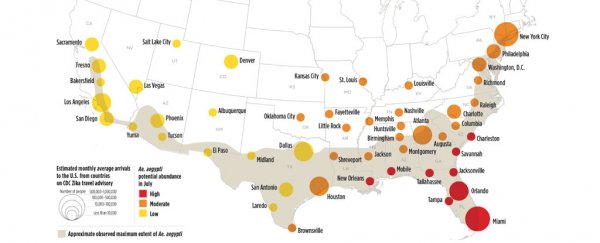Scientists have outlined which regions in the US are potentially at the highest risk of Zika virus outbreaks as the North American summer approaches.
With warmer temperatures on their way, conditions favourable to populations of the Aedes aegypti mosquito that spreads the infection mean that areas in the southern and eastern United States are most vulnerable to transmission of the virus. In addition to their temperate climates, much of this region is also located nearest to the current outbreak further south in Latin America and the Caribbean.
According to the researchers, areas on the east coast as far north as New York City could expect moderate abundance of Aedes aegypti, which is expected to decline as you move west. In the southeast it's a different story, however, with warm conditions in cities such as Miami expected to attract high populations of mosquitoes.
This doesn't mean Zika virus outbreaks are a certainty in any of these areas – just that the insect populations during summer could make outbreaks more likely if infections start spreading in significant numbers. Other factors affecting risk are travel patterns, and impoverishment – which brings greater exposure to the outdoor environment. Both of these factors have been incorporated into the computer simulations behind the map.
"This research can help us anticipate the timing and location of possible Zika virus outbreaks in certain US cities," said Andrew Monaghan from the National Centre for Atmospheric Research (NCAR). "While there is much we still don't know about the dynamics of Zika virus transmission, understanding where the Aedes aegypti mosquito can survive in the US and how its abundance fluctuates seasonally may help guide mosquito control efforts and public health preparedness."
That said, there's no reason for alarm. The researchers who worked on this study – from the NCAR and NASA's Marshall Space Flight Centre – did so for the purpose of keeping other scientists and authorities on top of which areas face the most risk, to expressly help with efforts to limit the impact of Zika in the US.
"The results of this study are a step toward providing information to the broader scientific and public health communities on the highest risk areas for Zika emergence in the United States," said epidemiologist and co-author, Kacey Ernst from the University of Arizona. "We hope that others will build on this work as more information becomes available. All areas with an environment suitable to the establishment of Aedes aegypti should be working to enhance surveillance strategies to monitor the Aedes aegypti populations and human populations for disease emergence."
The virus is also not expected to spread as widely as it has in South America and elsewhere, largely due to the fact that North Americans spend much more of their time living and working in sealed and air-conditioned buildings.
"Even if the virus is transmitted here in the continental US, a quick response can reduce its impact," said NCAR scientist Mary Hayden.
The findings are reported in PLOS Currents Outbreaks. For more information and map data, see here.
